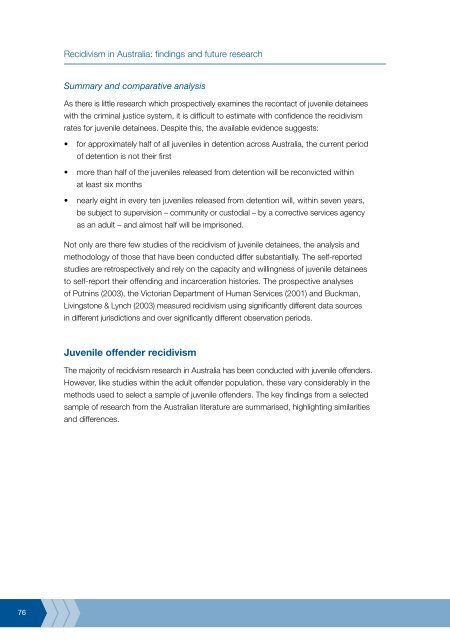Recidivism in Australia : findings and future research - Australian ...
Recidivism in Australia : findings and future research - Australian ...
Recidivism in Australia : findings and future research - Australian ...
You also want an ePaper? Increase the reach of your titles
YUMPU automatically turns print PDFs into web optimized ePapers that Google loves.
76<br />
<strong>Recidivism</strong> <strong>in</strong> <strong>Australia</strong>: f<strong>in</strong>d<strong>in</strong>gs <strong>and</strong> <strong>future</strong> <strong>research</strong><br />
Summary <strong>and</strong> comparative analysis<br />
As there is little <strong>research</strong> which prospectively exam<strong>in</strong>es the recontact of juvenile deta<strong>in</strong>ees<br />
with the crim<strong>in</strong>al justice system, it is difficult to estimate with confidence the recidivism<br />
rates for juvenile deta<strong>in</strong>ees. Despite this, the available evidence suggests:<br />
•<br />
•<br />
•<br />
for approximately half of all juveniles <strong>in</strong> detention across <strong>Australia</strong>, the current period<br />
of detention is not their first<br />
more than half of the juveniles released from detention will be reconvicted with<strong>in</strong><br />
at least six months<br />
nearly eight <strong>in</strong> every ten juveniles released from detention will, with<strong>in</strong> seven years,<br />
be subject to supervision – community or custodial – by a corrective services agency<br />
as an adult – <strong>and</strong> almost half will be imprisoned.<br />
Not only are there few studies of the recidivism of juvenile deta<strong>in</strong>ees, the analysis <strong>and</strong><br />
methodology of those that have been conducted differ substantially. The self-reported<br />
studies are retrospectively <strong>and</strong> rely on the capacity <strong>and</strong> will<strong>in</strong>gness of juvenile deta<strong>in</strong>ees<br />
to self-report their offend<strong>in</strong>g <strong>and</strong> <strong>in</strong>carceration histories. The prospective analyses<br />
of Putn<strong>in</strong>s (2003), the Victorian Department of Human Services (2001) <strong>and</strong> Buckman,<br />
Liv<strong>in</strong>gstone & Lynch (2003) measured recidivism us<strong>in</strong>g significantly different data sources<br />
<strong>in</strong> different jurisdictions <strong>and</strong> over significantly different observation periods.<br />
Juvenile offender recidivism<br />
The majority of recidivism <strong>research</strong> <strong>in</strong> <strong>Australia</strong> has been conducted with juvenile offenders.<br />
However, like studies with<strong>in</strong> the adult offender population, these vary considerably <strong>in</strong> the<br />
methods used to select a sample of juvenile offenders. The key f<strong>in</strong>d<strong>in</strong>gs from a selected<br />
sample of <strong>research</strong> from the <strong>Australia</strong>n literature are summarised, highlight<strong>in</strong>g similarities<br />
<strong>and</strong> differences.















